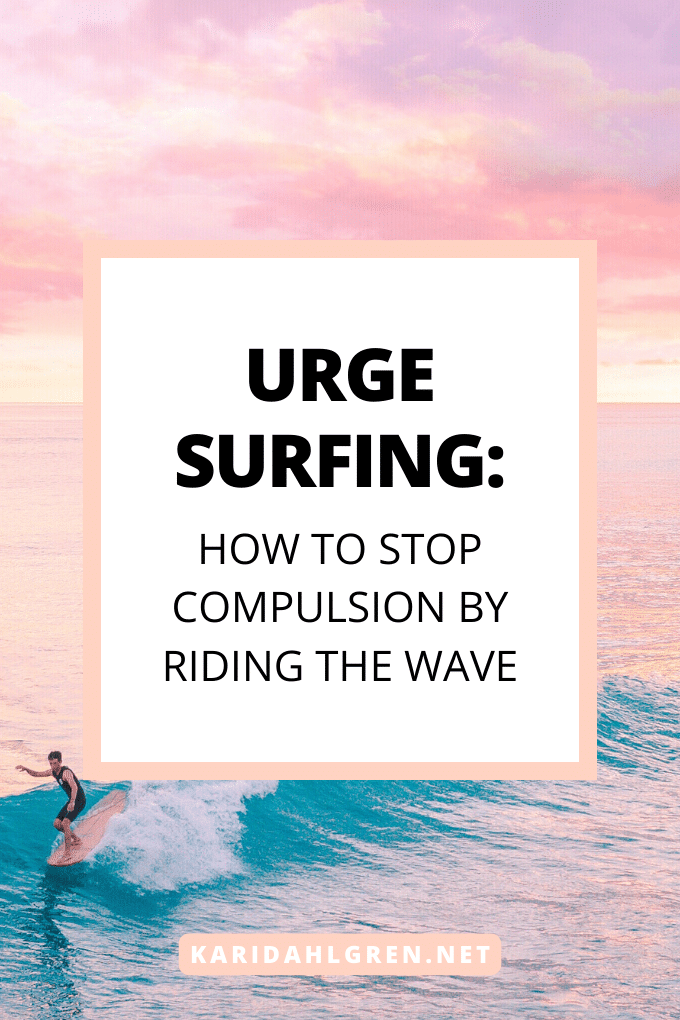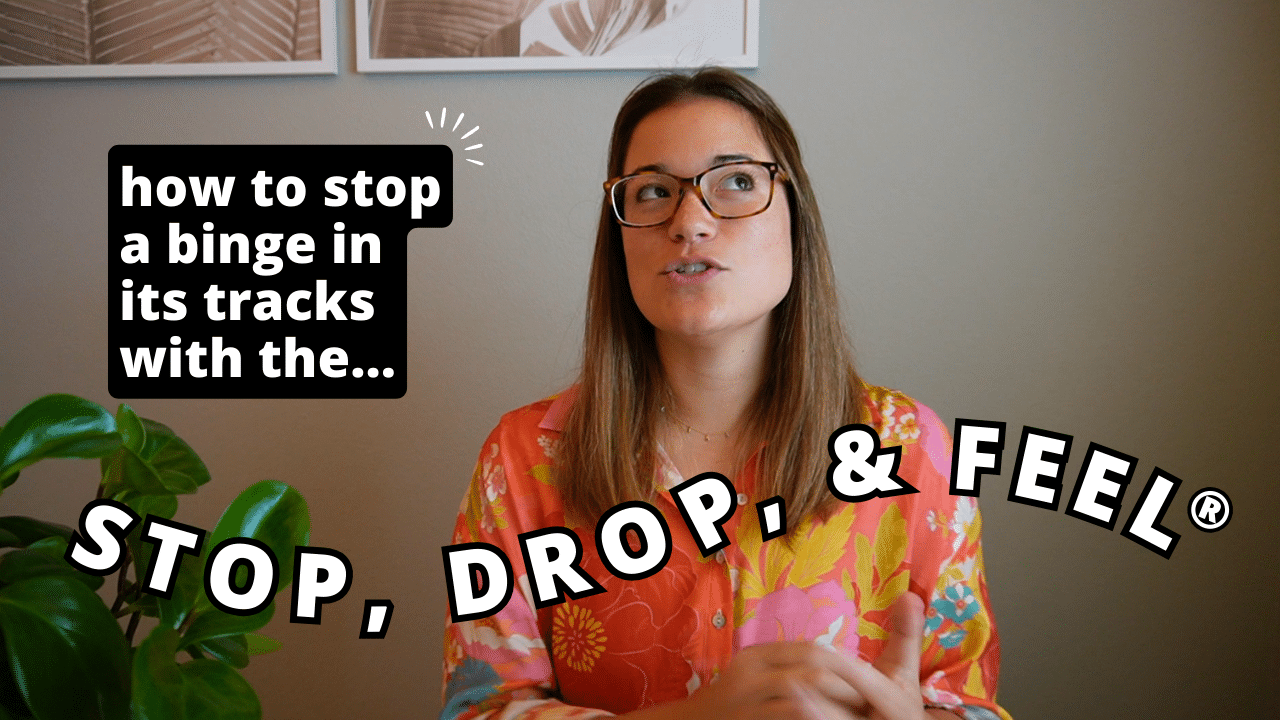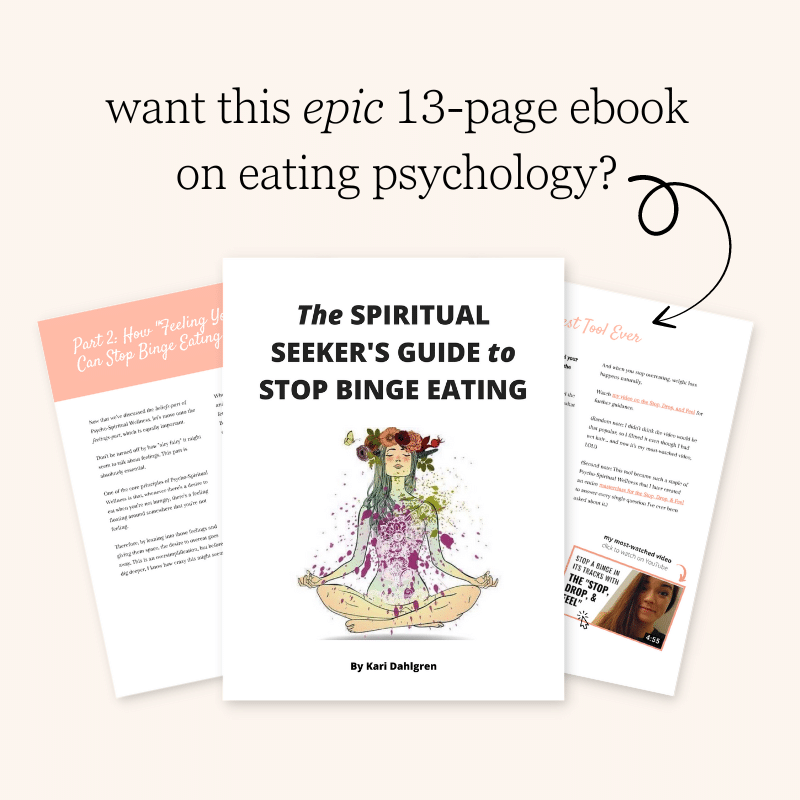
Do you ever feel a magnetic pull to reach for food without hunger or scroll through your phone instead of productively engaging in your day? When compulsion starts to interfere with your daily life, tools like urge surfing can help.
Urge surfing is a mindfulness technique that encourages you to “ride out” an urge or craving without acting on it—ideally. Sometimes urge surfing can stop an urge or craving, and other times it can’t. The good news is that with time and practice, urge surfing can help you build the necessary emotional skills to stop compulsion in the long run.
Urge surfing was an important and pivotal tool in how I stopped overeating. I actually coined and created my Stop, Drop, & Feel® technique—a method for stopping compulsive eating that involves urge surfing—before I even knew this clinical jargon.
We will talk more about urge surfing specifically in the realm of stopping overeating later in this article, but first let’s discuss the broad application of this useful tool.
What Is Urge Surfing?
Urge surfing is a tool for stopping compulsion based on the principle that urges—just like waves—rise, peak, and eventually fade away. The idea behind urge surfing is that, when you observe your urges without judgment and without trying to suppress or act on them, you can learn to tolerate the discomfort they bring.
This process is closely related to the concept of distress tolerance, which is the ability to endure emotional discomfort without resorting to maladaptive coping mechanisms. I also refer to it as emotional tolerance because everyone’s experience of distress is different—as even positive emotions can elicit compulsion if someone finds them vulnerable, for example.
Urge surfing can be applied to a wide range of compulsions, including but not limited to:
- Overeating
- Fast eating
- Workaholism
- Excessive social media use
- Excessive shopping
- Body checking
- Gambling
- Smoking
- Substance use and abuse
- Nail biting
- Excessive gaming or internet use
- Over-exercising
- Compulsive cleaning
- Procrastination
- Rumination
Research has shown that mindful awareness and distress tolerance are emerging as robust predictors of mental health, especially in populations with high levels of stress or trauma exposure.[1]
A recent study found that among first responders who were more intolerant to distress, mindful awareness had a stronger association with lower anxiety and depression symptoms.[1] This suggests that promoting both mindful awareness and distress tolerance—through tools such as urge surfing—can make a positive impact on mental health.
How to Surf an Urge
You might be interested in urge surfing if you find yourself struggling with compulsive behaviors or feeling overwhelmed by strong urges that disrupt your daily life. Urge surfing offers a mindful approach to managing these impulses without succumbing to them—if not at first, then in the long run.
By practicing urge surfing, you can develop greater self-awareness and emotional resilience, allowing you to navigate life’s challenges with more ease and less reliance on “buffering” mechanisms.
Here are some steps and tips for practicing urge surfing:
- Recognize the Urge: Acknowledge that you’re experiencing an urge without judging yourself. For example, you might notice the desire to reach for a cigarette or the impulse to continue working beyond healthy limits.
- Set a Timer: In my practice, I’ve found a timer to be exceptionally helpful with urge surfing because it creates a clear boundary. When you know the precise moment that you’re “off the hook,” it motivates you to actually use the tool of urge surfing instead of procrastinating.
- Observe the Physical Sensations and Emotions: Pay attention to the physical sensations associated with the urge. Where do you feel it in your body? Is it a tightness, a warmth, or something else? Also pay attention to any emotions that are present. For example, do you feel edgy, stressed, or anxious?
- Place Your Hands on Heart: I personally like to close my eyes and place my hands on my heart to encourage introspection. I find the somatic element of hands placed over my heart helps me avoid mind-wandering and stay with the urge longer.
- Visualize the Urge as a Wave: Imagine the urge as a wave in the ocean. It builds, peaks, and eventually dissipates. Remind yourself that the urge will pass—except in the case of the urge to eat in the presence of physical hunger. Urge surfing cannot override biological cues; it works on psychological cue.
- Stay Present: Continue to observe the urge without acting on it. If your mind wanders, gently bring your attention back to your breathing, noticing physical sensations and emotions.
- Reflect: If the urge has passed, take a moment to reflect on the experience. How do you feel now? What did you learn about your ability to tolerate discomfort?
In my practice, I find a timer to be a helpful element of urge surfing, especially for someone in the grips of strong compulsion. Often, when someone thinks about urge surfing and riding their urge out all the way until it ends, it can feel like an insurmountable task and procrastination prevents you from getting started. By setting a timer, there’s a clear boundary and it helps reduce procrastination and make urge surfing more accessible.
Also, it’s important to understand that urge surfing may not stop compulsion right away. Consistent practice is key to building emotional tolerance, which paves the way to stopping compulsion in the long run. Just like willpower is strengthened through repetition[2], so is your ability to manage compulsions through the repeated practice of urge surfing.
How to Apply Urge Surfing to Compulsive Eating
If you struggle with the urge to eat beyond fullness or eat without hunger (compulsive eating), urge surfing can help as low tolerance to distress is correlated with overeating.[3], [4] Because this is my area of expertise as an eating psychology coach, I have even more tips to help apply urge surfing in this area.
My Stop, Drop, & Feel® technique involves the application of urge surfing specifically to compulsive eating. It’s a mindful, emotional tolerance-building approach that helps you pause and connect with your authentic emotions before acting on the impulse to eat past fullness or start eating without hunger.
Here’s how it works:

- Stop: When you feel the urge to eat compulsively, stop and set a timer for two minutes, or your desired length of time. Promise yourself that you can eat exactly what appeals to you when the timer goes off to prevent the restrict-binge cycle (more on this soon). This pause creates a space between the urge and the action, giving you a chance to choose a different response.
- Drop: Next, drop into your body by bringing your awareness to your physical sensations and emotions. Notice any tension, edginess, discomfort, or other sensations and emotions that might be present.
- Feel: Allow yourself to feel your feelings without judgment and try to experience them fully. Observe how the emotions often lose their power, just like a wave that’s approaching shore.
For some people, the SDF can stop a binge in its tracks on the first go. For others, practice is required to build enough emotional tolerance to begin seeing results. Stay dedicated and use small goals to prevent burnout.
Also, the ‘stop’ can feel like the hardest step of the Stop, Drop, & Feel® technique, especially when eating feels out of control. What helps make the ‘stop’ accessible is the promise that you can eat exactly what appeals to you when the timer goes off. This element of permission helps prevent the SDF from becoming a form of restriction, which would otherwise trigger the restrict-binge cycle.
As you begin to practice this tool over time—even just once a day, 2 minutes at a time—it can help you stop compulsive eating by increasing your ability to tolerate uncomfortable emotions without using food as a buffer.
There’s much more that goes into the Stop, Drop, & Feel, and I’ve refined it over the last 7 years through personal experience and that of my clients and readers. If you want a step-by-step roadmap to stopping compulsive eating using this tool, I highly recommend my online course, The Stop, Drop, & Feel® Masterclass.
Tips to Make Urge Surfing More Accessible
Now that you know the general steps for applying urge surfing to compulsion such as overeating, let’s discuss some extra tips to refine your urge surfing practice. The more skillfully you can apply this tool, the greater your self-awareness and emotional tolerance will be.
Here are some extra tips for urge surfing:
- Embrace Balance, Not Perfectionism: It’s important to avoid setting all-or-nothing goals such as completely eliminating TV, internet, and social media use all at once. While it’s good to be mindful of time spent on these activities, some indulgence is necessary for joy and leisure. The key is to discover the subtle line between enjoying mindless activities in moderation and when they start to become compulsive or used as a buffer.
- Focus on One Urge at a Time: Trying to tackle multiple urges simultaneously can be overwhelming. Concentrate on one urge at a time to avoid burnout and all-or-nothing mentality.
- Prioritize Sleep: Good quality sleep is essential for managing urges effectively. Lack of sleep can weaken your resolve and make it harder to hold space for compulsive urges.
- Reduce Stress: High levels of stress can exacerbate urges and make them harder to manage. Engage in stress-reducing activities like meditation, exercise, or hobbies that relax you.
- Avoid Undereating: Even the most skilled urge-surfer can’t outsmart the body’s reaction to undereating, which includes the release of hunger hormones to motivate eating.[5] Not only does undereating weaken your resolve with urge surfing, but it also triggers overeating.
- Stay Mindful of Mood-Altering Substances: Some people need mood-altering substances like antidepressants for mental health, and it’s important not to discourage healthy use of these substances, especially when prescribed by a physician.
Instead, stay mindful and curious about their effects on you. Know that mood-altering substances may suppress urges temporarily, but it can create a dependency. Simply stay curious and engage in open communication with your healthcare provider about if or when the time is right to reduce it.
Conquering Compulsion with Urge Surfing
Urge surfing is a powerful tool that can help you navigate the complex landscape of compulsions and cravings. Whether you’re dealing with overeating, workaholism, excessive social media use, or any other compulsion, urge surfing offers a pathway to greater emotional tolerance and resilience.
I can personally attest to the effectiveness of urge surfing because it’s how I stopped binge eating; and it’s a pillar of my approach to stopping compulsive eating, Psycho-Spiritual Wellness. If you want to learn more, you can get a free 5-day email course in Psycho-Spiritual Wellness when you sign up for my free ebook below:



